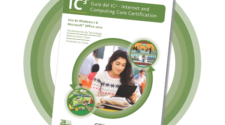 Based on research featured by the United States Department of Education, 15-20% of Americans are affected by learning disabilities and approximately 5% of them are children.
Based on research featured by the United States Department of Education, 15-20% of Americans are affected by learning disabilities and approximately 5% of them are children.
With the help of technological tools, students with learning disabilities are offered a way to absorb lessons better and faster than before, and become more productive. Technology is a tool for empowerment as it creates a collaborative and innovative space for all learners.
“Students of any age are turning to online education and e-Learning because it offers the flexibility, convenience and acceleration they need to gain their credentials as fast as they can,” said Carol Aslanian, founder of Aslanian Marker Research and the Learning House.
Learning on the go
With the aid of mobile devices, e-Learning is becoming a common platform for students to learn on the go. A study revealed that almost 60% of online students use their mobile devices for classwork, making it easier for modern students to use e-Learning platforms.
While desktop PCs continue to be an important learning tool for students in and outside the classroom, smartphones and tablets are now slowly replacing them. New forms of mobile devices are now offering the same high-tech features and the same power as desktop computers (64-bit processor and high-speed internet, among other features). In fact, tech experts forecast that mobile devices will replace PCs in the future, especially since users want a more portable device to use daily. Students have the same sentiments regarding their choice of learning platform, with portability being a common need.
However, students with learning difficulties require certain features in a mobile tool. According to O2, here are the common specifications to look out for:
- Lightweight and easy to grip
- Multi-touch display
- A physical keypad with large, well-spaced button
- Easy to use
- Added feature: voice activation, pinch to zoom, and accessibility settings
Important Facts About Learning Disabilities
Even with the right tool, teachers need to know the following important facts about learning disabilities in e-Learning to make the process effective.
- There are various types of learning disabilities. It shouldn’t be confused with developmental disorders, such as autism or intellectual disability. In order to create a valuable tool, the tool should be able to address the weakness of the student.
- It differs from person to person. Learning disabilities vary, as they do not affect everyone in the same way. The impact differs depending on the individual and the situation.
- Self-disclosure of learning disabilities is rare. The impersonal nature of e-Learning platforms discourages some to seek help, which makes it difficult to know about their learning disability.
- Feedback is essential. Maintaining communication with learners will help them get the most out of their e-Learning experience. It will also allow you to assess the effectiveness of the platform and make the necessary improvements.
Flexible e-Learning tools are the best solution for students with learning disabilities. The more flexible the platform is, the easier it is for all students to participate. The more options being offered to learners, the more they will be able to demonstrate their knowledge and enhance the skill sets they need.
Exclusively written for CCILearning by TeachingJB
About the Author
Jennifer Birch (TeachingJB) has been in the blog-o-sphere for three years after leaving her work as an English teacher in South Korea. She still continues her passion in education by signing up as an online educator. She hopes to see more developments in edtech, especially with the rise of virtual reality and other new innovative solutions for education.





